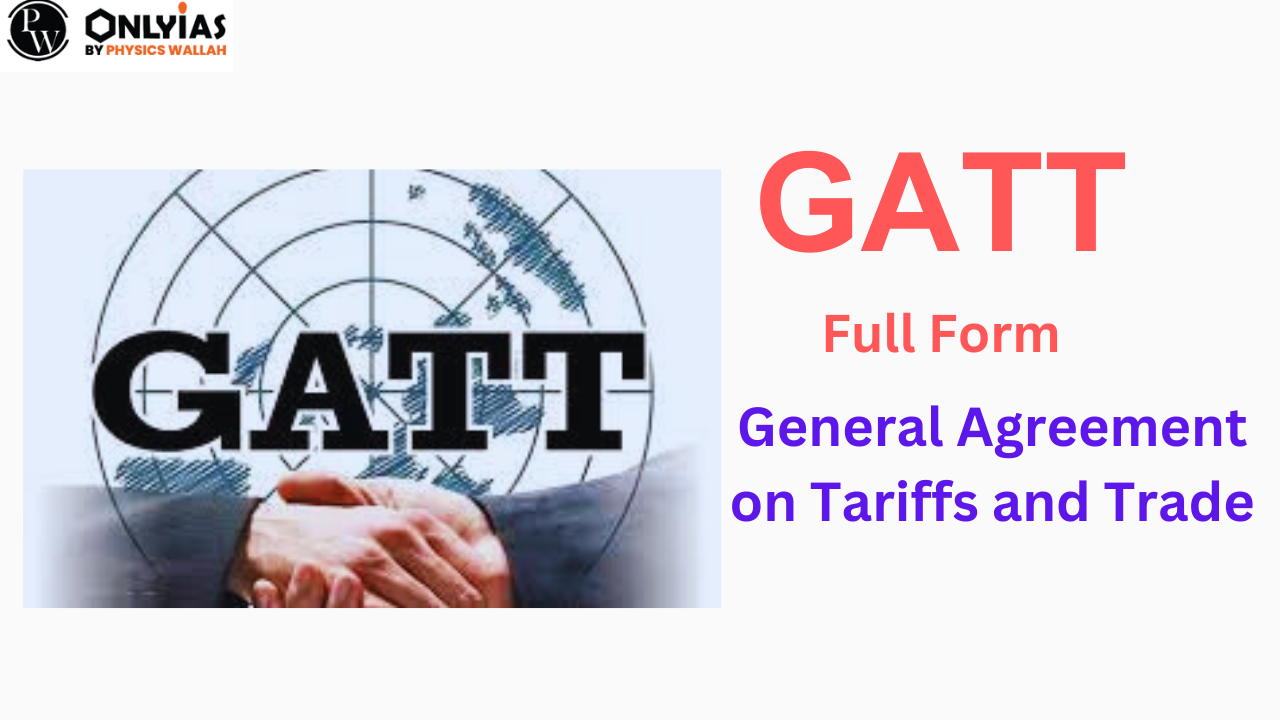![]() Ananya Gupta
Ananya Gupta
![]() August 25, 2023 11:10
August 25, 2023 11:10
![]() 3960
3960
![]() 0
0
GATT full form stands for General Agreement on Tariffs and Trade. Learn about its full form, functions, transition to the WTO, benefits, limitations, and key conferences in this comprehensive guide.

GATT stands for “General Agreement on Tariffs and Trade.” It was an international treaty established in 1947 to promote international trade by reducing or eliminating trade barriers such as tariffs and quotas. GATT provided a framework for negotiations among member countries to reach agreements on trade-related issues and to facilitate the exchange of goods and services across borders. In 1995, GATT was replaced by the World Trade Organization (WTO), which incorporated and expanded upon the principles and provisions of GATT while also addressing additional aspects of international trade, including services and intellectual property.
| GATT Full Form | |
|---|---|
| Full Form | General Agreement on Tariffs and Trade |
| Signed | 30 October 1947 |
| Location | Geneva, Switzerland |
| Type | Multilateral treaty |
GATT का पूरा नाम “सामान्य आकस्मिक शुल्क और व्यापार पर समझौता” है। यह 1947 में स्थापित एक अंतरराष्ट्रीय संधि था जिसका उद्देश्य अंतरराष्ट्रीय व्यापार को बढ़ावा देना और व्यापारिक बाधाओं को कम करना था। GATT ने सदस्य देशों के बीच व्यापार के विषयों पर समझौते और साझेदारी को सुविधाजनक बनाने के लिए एक ढांचा प्रदान किया। 1994 में, GATT को विश्व व्यापार संगठन (WTO) ने बदल दिया, जिसमें GATT के सिद्धांतों और प्रावधानों को समाहित किया गया और साथ ही अंतरराष्ट्रीय व्यापार के अतिरिक्त पहलुओं को भी समालेना जाता है, जैसे कि सेवाएँ और बौद्धिक संपदा।
The General Agreement on Tariffs and Trade (GATT) was a multilateral international treaty that aimed to promote and regulate international trade. It was established in 1947 and operated until 1994, when it was replaced by the World Trade Organization (WTO). GATT’s primary objective was to reduce trade barriers and promote economic cooperation among its member countries.
Key features of the GATT included:
The idea of a General Agreement on Tariffs and Trade (GATT) was proposed during the United Nations Monetary and Financial Conference, also known as the Bretton Woods Conference, held in Bretton Woods, New Hampshire, USA, in July 1944. The conference aimed to create a framework for the post-World War II international economic order.
The concept of GATT was put forth by Harry Dexter White, an American economist and senior U.S. Treasury official, as part of the U.S. delegation led by John Maynard Keynes and Harry Dexter White. The idea was to establish an international organization that would address trade barriers and promote economic cooperation among nations to prevent the kind of protectionism and trade wars that had contributed to the Great Depression and exacerbated global tensions in the interwar period.
The proposal for GATT gained support from other participating countries at the conference, and it eventually led to the establishment of the General Agreement on Tariffs and Trade in 1947, when representatives from 23 countries signed the agreement in Geneva, Switzerland. GATT’s foundational principles and mechanisms laid the groundwork for the multilateral trading system, which aimed to reduce trade barriers and promote international trade in a cooperative manner.
The General Agreement on Tariffs and Trade (GATT) had a varying number of member countries throughout its existence. It began with 23 original contracting parties when it was established in 1947. Over the years, the number of member countries grew as more nations joined the agreement. By the time GATT was succeeded by the World Trade Organization (WTO) in 1995, there were 128 member countries.
The General Agreement on Tariffs and Trade (GATT) served several important functions to facilitate international trade and promote economic cooperation among its member countries. Some of the key functions of GATT were:
The General Agreement on Tariffs and Trade (GATT) was replaced by the World Trade Organization (WTO) to address limitations in the GATT system and to establish a more comprehensive and effective framework for regulating international trade. There were several reasons for transitioning from GATT to the WTO:
The General Agreement on Tariffs and Trade (GATT) brought about several significant benefits for its member countries and the global economy. Some of the key benefits of GATT include:
While the General Agreement on Tariffs and Trade (GATT) brought about numerous benefits, it also had its limitations and challenges. Some of the key limitations of GATT include:
The General Agreement on Tariffs and Trade (GATT) convened several rounds of negotiations, often referred to as trade rounds or conferences, during its existence. These conferences aimed to negotiate and reach agreements on various trade-related issues among member countries. Some of the notable conferences held by GATT include:
No, the General Agreement on Tariffs and Trade (GATT) is no longer in effect as a standalone international agreement. GATT operated from its establishment in 1947 until it was succeeded by the World Trade Organization (WTO) in 1995.
The GATT framework was incorporated into the WTO, which was established to provide a more comprehensive and modernized approach to regulating international trade. The agreements and principles that were part of GATT were integrated into the WTO’s structure, and the WTO continued the work of GATT in promoting open and fair global trade.
While GATT itself is not operational anymore, its legacy lives on through the WTO, which builds upon the foundation laid by GATT and extends its principles to cover not only trade in goods but also services, intellectual property, dispute resolution, and other aspects of modern international trade.
| Related Links | |
|---|---|
| UPSC IAS Salary | UPSC Management Syllabus |
<div class="new-fform">
</div>

Latest Comments